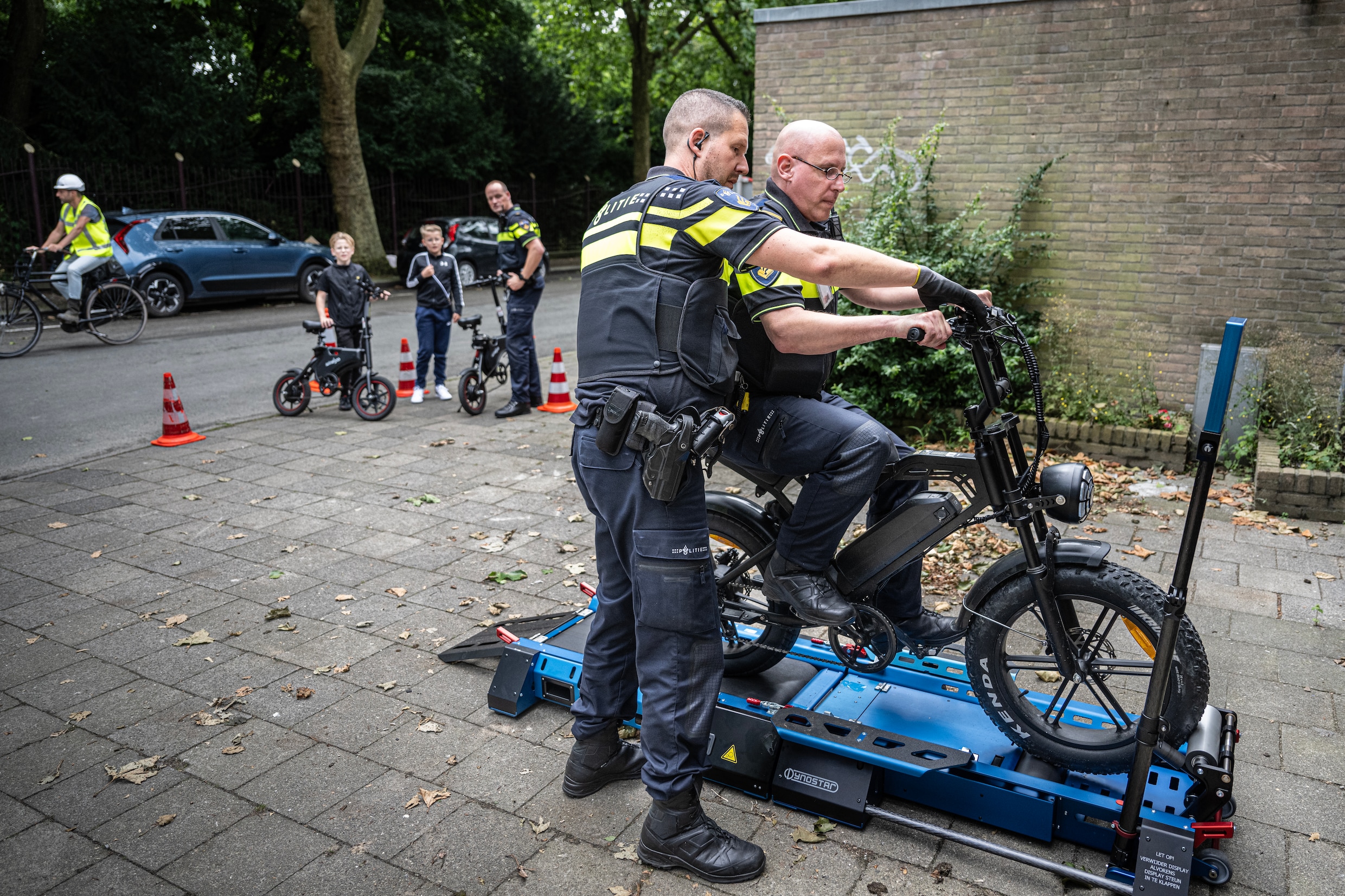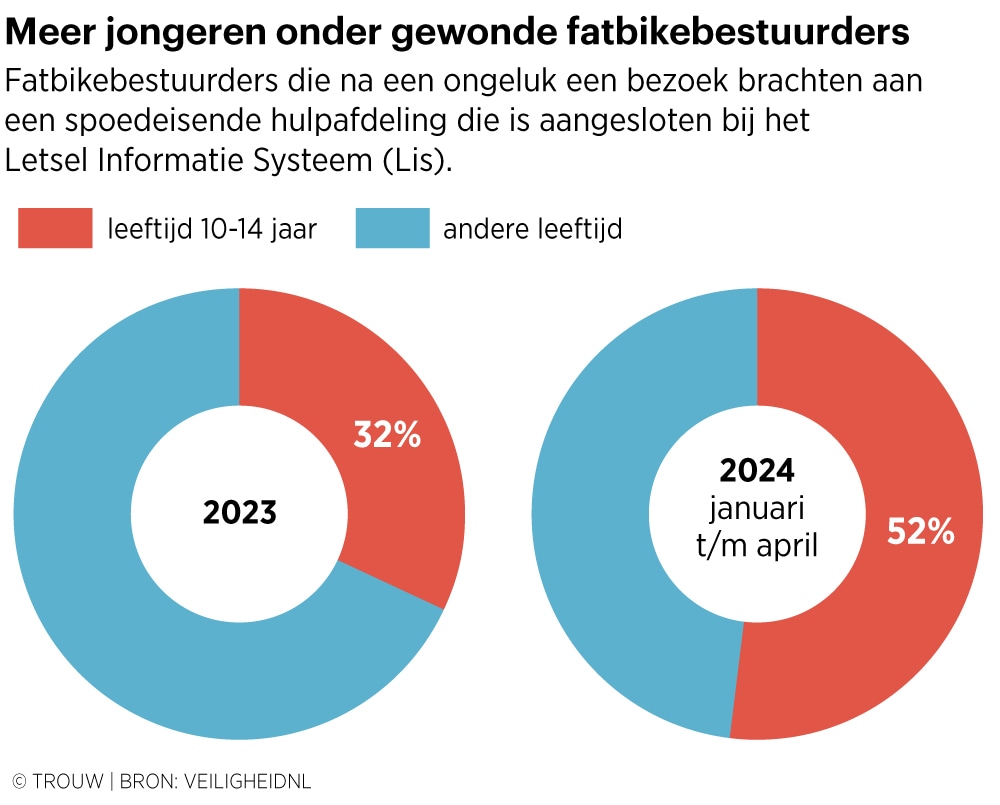With thick tires and a low seat, fat riders move effortlessly forward. E-bikes easily reach the top speed of 25 kilometers per hour, regardless of how hard you pedal. And with the push of a button you can even increase the speed from 40 to 50 kilometers per hour, via an app on your phone. It feels like riding a scooter, with the wind in your hair. But all without a helmet, no minimum age and only on the bike path.
For many children, the temptation is great. Fat bikes make them feel like kings of the road, much to the chagrin of others, and not without risks: the number of accidents involving children aged 10 to 14 on fat bikes is increasing considerably (as described above). Can these young fat cyclists safely participate in traffic?
The teenage brain likes risks
There is no specific research on teenagers riding fatbikes yet, but a lot is known about how young people behave in traffic. For example, we know from neuroscience that the teenage brain is still developing and likes to push boundaries. Areas of the brain that prefer quick rewards develop before those that assess danger. As teenagers get older, this imbalance diminishes and they exhibit less risky behaviors.
The cycling movement itself is not the problem; the motor skills of children aged 10 to 14 are remarkably good. The coordination area of the brain develops rapidly between the ages of 6 and 10. It is therefore not surprising that a ten-year-old can perform tricks on a skateboard more easily than an adult.
But teenagers have more difficulty assessing complex traffic situations. “Participation in traffic requires much more than just motor skills,” says Jelle Jolles, emeritus professor of neuropsychology at the Vrije Universiteit. “It’s all about perception – with your ears, your eyes and your sense of direction. You have to be able to anticipate unexpected situations, such as a car door opening or a child suddenly crossing the road.”

The parts of the brain needed for complex situations, such as in traffic, are far from fully developed in teenagers. “Think about considering consequences, assessing other people’s intentions, and understanding the consequences of your own actions,” says Jolles. “Plus, most 10- to 14-year-olds still have little self-awareness and are still learning to regulate their behavior.”
‘Traffic is too complex for teenagers’
Brain functions such as self-awareness and self-regulation develop between the ages of twenty and twenty-five. Jolles points out that there is already a clear difference between a 12-year-old and a 16-year-old, which has to do with the acquisition of experience. “From birth you already have simple brain networks in your brain,” he explains. “These networks are initially narrow, comparable to paths through a wasteland. They can then process very little information. As you gain more experience, these paths become wider and better paved. They become two-lane highways, four-lane highways, and by the age of twenty or twenty-five, they are wide highways.”

Teenagers simply cannot yet rely on their brain networks to safely navigate high-speed traffic. “Most children between the ages of 10 and 14 do not have sufficient skills to handle the fat bike in complex situations such as heavy traffic,” says Jolles.
At high speeds, traffic situations become even more complex, because social and motor information must be processed more quickly, explains the neuropsychologist: “In the city or in a built-up area, a speed of more than 20 kilometres per hour is already high. The adolescent brain has difficulty processing information under time pressure and in complex situations, especially when the interests of others or emotions also play a role. Since a 12-year-old child has not yet acquired all the knowledge and experiences, the time to process information quickly becomes too short.”
Fat young cyclists end up in emergency rooms more often
Many more young children are visiting the emergency room after an accident on their fat bike than before. This is shown by the figures from the Injury Information System (LIS) of VeiligheidNL, a knowledge centre for injury prevention. The number of registered accidents is increasing, but the percentage of children aged 10 to 14 is increasing even faster. More than half of all injuries in the first few months of this year were among children aged 14 or younger.
These figures come with a number of caveats. For a start, fatbike use is increasing, so it stands to reason that the number of accidents is also on the rise.
The figures from the Injury Information System are also a good example. SafetyNL records figures from 14 emergency services, but there are 83 such services in the whole of the Netherlands. Above all, the number of injured people is structurally underestimated. Many victims do not go to the emergency room, but to their family doctor, for example, or do not seek medical attention at all.
So the number of recorded accidents tells us little, but the change in that number tells us even more. The same emergency departments that treated 19 injured fat bikers aged 10 to 14 in 2023 already treated 17 in the first four months of 2024. It is therefore impossible to say how many injured people are involved nationally, but the increase in the fourteen hospitals monitored is so high that it is almost certain that the number of injured nationally will also increase.
The number of very young people injured compared to other age groups is also striking. Compared to the 17 injured people aged 10 to 14 in the first four months of 2024, there are 7 people aged 15 to 17. During the same period, 8 adult cyclists were injured. The relatively low proportion of people aged 16 and over who are involved in accidents with fat bikes does not necessarily mean that they ride more safely. It will also be because this age group is allowed to ride a moped and more often ignores the fat bike.
Read also:
Boosting the fat bike? Piece of cake!
Some fat bike manufacturers make it easy to upgrade electric bikes. Young people are unaware of the danger, say officers during a police check.
Know your hotspot, save the cyclist
In 2021, Trouw took stock of bicycle safety in the Netherlands. Read all the reports and tips for increasing safety here.
Editorial: The fat bike is not a bicycle
The fat bike is not a bicycle. This is a simple but complicated observation, because according to the law the means of transport is actually an (electric) bicycle. This means that no helmet is required, no minimum age, and no driving licence. An unsustainable situation. The legislature must intervene quickly.





